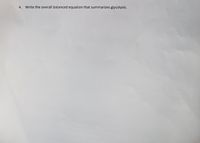
Biochemistry
9th Edition
ISBN: 9781319114671
Author: Lubert Stryer, Jeremy M. Berg, John L. Tymoczko, Gregory J. Gatto Jr.
Publisher: W. H. Freeman
expand_more
expand_more
format_list_bulleted
Question

Transcribed Image Text:4. Write the overall balanced equation that summarizes glycolysis.
Expert Solution
This question has been solved!
Explore an expertly crafted, step-by-step solution for a thorough understanding of key concepts.
This is a popular solution
Trending nowThis is a popular solution!
Step by stepSolved in 2 steps with 1 images

Knowledge Booster
Similar questions
- 1. Write out the mechanism of TIM-catalyzed reaction in the direction it goes in glycolysis. Show involved enzymatic residues.arrow_forward1. What role does oxygen play in the ETC? What ultimately happens to that oxygen? (What compound(s) does it become?) 2. What are the rate-limiting enzymes of glycolysis and the TCA cycle? Glycolysis: TCA:arrow_forward23. The substrate used in the LAST step of glycolysis is _____. Select one: a. phosphoenolpyruvate b. pyruvate c. glyceraldehyde-3-phosphate d. 1,3-bisphosphoglyceratearrow_forward
- 19. Clearly distinguish between the 3 parts of glycolysis.arrow_forward7. In the ketone body pathway, both acetoacetate and B-hydroxy butyrate are produced and become additional fuel molecules for the organism. a. Define where these molecules are produced (both tissue type and location in the cell) and what tissue they "feed". b. Of these two molecules, which one is considered slightly better in delivering more energy to the target tissue? Why? c. How does acetone, another ketone body, participate in delivering fuel to target tissue? d. If acetoacetate decarboxylase enzyme was mutated and became inactive (zero enzyme activity), how would this affect the ketone pathway during these conditions: į. immediately after a meal, ii. under starvation conditions, iii. during unchecked (not being treated for) type-1 diabetes.arrow_forward17. The prefix glycol comes from the Greek word that means “sweet” and the suffix lysis fromGreek word that means “to loosen” Explain how the meaning of these word parts arerelated to definition of glycolysis.arrow_forward
- 4. the first two reactions in glycolysis associated with unfavorable AG° values, i.e., AGº > 0, both produce a product with high phosphoryl group transfer potential. (ATP formation is not considered here.) Compare the two reactions and describe what the driving force is for both reactions that allows glycolysis to proceed to formation of pyruvate.arrow_forward1. Answer the following questions about the flow chart below: phosphoglucomutase glucose glucose-6-phosphate glucose-1-phosphate ATP ADP UTP UDP-glucose pyrophosphorylase glycogen synthase glycogen-glucose UDP-glucose + PP; (a) What metabolic process is this depicting? A. glycolysis B. gluconeogenesis C. glycogenolysis D. glycogenesis (b) Is this an anabolic or catabolic process? (c) What is the name of the enzyme that makes the transformation in the first step? (d) Phosphoglucomutase belongs to which of the six cdasses of enzymes? (e) What does "UTP" stand for? What kind of biological molecule is it?arrow_forward7. What does aerobic mean vs anaerobic? 8. Using words and symbols, write the overall equation for cellular respiration.arrow_forward
arrow_back_ios
SEE MORE QUESTIONS
arrow_forward_ios
Recommended textbooks for you
 BiochemistryBiochemistryISBN:9781319114671Author:Lubert Stryer, Jeremy M. Berg, John L. Tymoczko, Gregory J. Gatto Jr.Publisher:W. H. Freeman
BiochemistryBiochemistryISBN:9781319114671Author:Lubert Stryer, Jeremy M. Berg, John L. Tymoczko, Gregory J. Gatto Jr.Publisher:W. H. Freeman Lehninger Principles of BiochemistryBiochemistryISBN:9781464126116Author:David L. Nelson, Michael M. CoxPublisher:W. H. Freeman
Lehninger Principles of BiochemistryBiochemistryISBN:9781464126116Author:David L. Nelson, Michael M. CoxPublisher:W. H. Freeman Fundamentals of Biochemistry: Life at the Molecul...BiochemistryISBN:9781118918401Author:Donald Voet, Judith G. Voet, Charlotte W. PrattPublisher:WILEY
Fundamentals of Biochemistry: Life at the Molecul...BiochemistryISBN:9781118918401Author:Donald Voet, Judith G. Voet, Charlotte W. PrattPublisher:WILEY BiochemistryBiochemistryISBN:9781305961135Author:Mary K. Campbell, Shawn O. Farrell, Owen M. McDougalPublisher:Cengage Learning
BiochemistryBiochemistryISBN:9781305961135Author:Mary K. Campbell, Shawn O. Farrell, Owen M. McDougalPublisher:Cengage Learning BiochemistryBiochemistryISBN:9781305577206Author:Reginald H. Garrett, Charles M. GrishamPublisher:Cengage Learning
BiochemistryBiochemistryISBN:9781305577206Author:Reginald H. Garrett, Charles M. GrishamPublisher:Cengage Learning Fundamentals of General, Organic, and Biological ...BiochemistryISBN:9780134015187Author:John E. McMurry, David S. Ballantine, Carl A. Hoeger, Virginia E. PetersonPublisher:PEARSON
Fundamentals of General, Organic, and Biological ...BiochemistryISBN:9780134015187Author:John E. McMurry, David S. Ballantine, Carl A. Hoeger, Virginia E. PetersonPublisher:PEARSON

Biochemistry
Biochemistry
ISBN:9781319114671
Author:Lubert Stryer, Jeremy M. Berg, John L. Tymoczko, Gregory J. Gatto Jr.
Publisher:W. H. Freeman

Lehninger Principles of Biochemistry
Biochemistry
ISBN:9781464126116
Author:David L. Nelson, Michael M. Cox
Publisher:W. H. Freeman

Fundamentals of Biochemistry: Life at the Molecul...
Biochemistry
ISBN:9781118918401
Author:Donald Voet, Judith G. Voet, Charlotte W. Pratt
Publisher:WILEY

Biochemistry
Biochemistry
ISBN:9781305961135
Author:Mary K. Campbell, Shawn O. Farrell, Owen M. McDougal
Publisher:Cengage Learning

Biochemistry
Biochemistry
ISBN:9781305577206
Author:Reginald H. Garrett, Charles M. Grisham
Publisher:Cengage Learning

Fundamentals of General, Organic, and Biological ...
Biochemistry
ISBN:9780134015187
Author:John E. McMurry, David S. Ballantine, Carl A. Hoeger, Virginia E. Peterson
Publisher:PEARSON